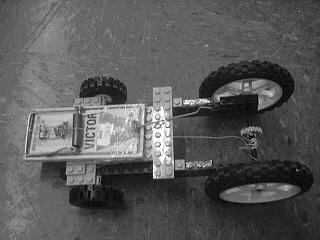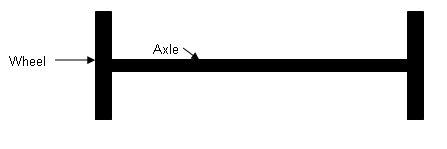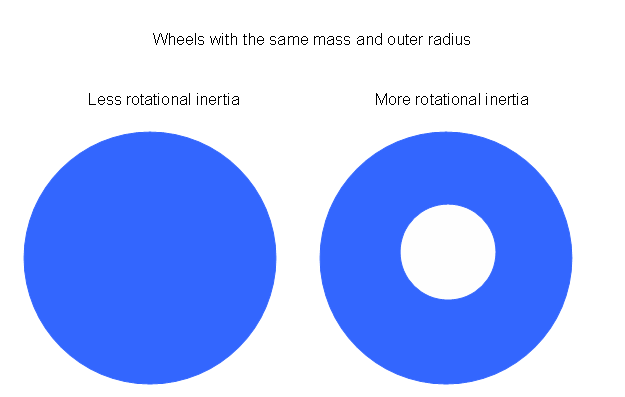Mousetrap Vehicle Competition
1 Objective
Using your knowledge of gear ratios, torque, and other basic physics concepts, build a vehicle powered only by a standard sized mousetrap that will travel the farthest linear distance.
2 Overview
Vehicles need a way to move, called propulsion. Propulsion is basically form of energy conversion, from a stored form into movement. The most common means of propulsion is to release the chemical energy in petroleum products to cause movements. The internal combustion engine in most automobiles works this way, as do jet engines. Small radio-controlled cars use propulsion where the chemical energy stored in batteries is converted into electricity, and this electricity drives an electric motor that moves the car.
Railroad locomotives do several forms of energy conversion to achieve propulsion. Usually a diesel engine converts the chemical energy in kerosene into rotary motion (turning), which drives an electric generator, producing electricity. This electricity is then sent to motors mounted on the locomotive's wheels, providing so much propulsion that the locomotive moves not only itself, but typically many train cars as well.
A recent development with automobiles is hybrid propulsion, where an internal combustion engine and a battery combine to provide propulsion. This is more efficient than a traditional automobile. In a traditional automobile, the internal combustion engine had to be large enough to provide good acceleration, but then also had to propel the car under normal circumstances, where it was too powerful and inefficient for the job. With a hybrid car, the battery is used for normal cruising where not much power is needed, and the internal combustion engine is only used where more power is required for acceleration or to recharge the battery. This way both propulsion sources do what they do best.
Almost any energy source can be used for propulsion with enough ingenuity. For example, a wind-up toy car converts the energy from your muscles in winding up the spring into motion when the car is released.
A mousetrap car is a vehicle using a mousetrap as a propulsion source. In a traditional mousetrap car, a string is attached to the lever arm of the mousetrap and the other end of the string is attached to the drive axle.
The string is looped around a "hook" on the axle. As the string is wrapped around the axle, the mousetrap's lever arm will be pulled back. When the mousetrap is activated, the lever arm will pull the string, which in turn will rotate the drive axle and propel the vehicle forward.
Principles involved in a Mousetrap Car
Friction:The force that resists the motion of two surfaces in contact. In a mousetrap car, a lot of power is lost due to friction between the axles and chassis and between the wheels and the ground. Not all friction is bad though; friction that prevents the wheels from slipping is called traction. In general, one may want to reduce the amount of friction, but have enough traction so that the wheels do not slip.
Rotational Inertia: The resistance an object has to changes in rotation. Mass of the object affects the amount of rotational inertia, the greater the mass, the greater the rotational inertia.
Rotational inertia is also dependent on the location of mass from the axis of rotation. The farther the bulk of mass is radially from the axis of rotation, the greater the rotational inertia.
3 Your Assignment
Individual Lab Report
Follow the lab report guidelines laid out in the page called Specifications for Writing Your Lab Reports in the Technical Communication section of this manual. As you write, the following discussion points should be addressed in the appropriate section of your lab report:
- Discuss the advantages and disadvantages of your design.
- Discuss the characteristics of the design that won the competition.
Extra credit will be awarded to the winner of the competition as described in the EG1003 Grading Policy. Make sure to get the sketch of the design signed by the TA as well as a photo and attach it to your lab report.
PowerPoint Presentation (Sections HS1 & HS2 Only)
For Sections A, B, C, D/H, E, G, and HS3: there is no presentation for Lab 1A.
Follow the presentation guidelines laid out in the page called EG1003 Lab Presentation Format in the Introduction to Technical Presentations section of this manual.
4 Competition Rules
- Only the Lego parts provided may be used.
- The vehicle must be powered solely by the mousetrap provided.
- The vehicle must have at least 1 wheel (no projectiles allowed)
- The mousetrap spring must not be physically altered.
- The vehicle may not receive a push at the start
- The vehicle cannot be touched once it has left the starting position.
- Displacement distance will be measured; not the total distance traveled.
- If the car hits another object (e.g. the wall), distance will be measured at the point of impact.
Scoring
The team with the greatest displacement distance traveled wins.
5 Materials
- Robolab kit
- Mousetrap
- Kevlar string
- Tape
6 Procedure
- Brainstorm about possible designs for a mousetrap car.
- Sketch your design on paper
- Construct your design based on your sketch
- The mousetrap may be attached to the car by tape (try not to use excessive amounts of tape; all tape should be removed from the Lego parts before leaving).
- Load the mousetrap by winding the string around the drive axle.
- Once your team is ready, position the vehicle behind the starting line and release it.
- Once the vehicle comes to a stop, your team may decide to keep the current distance or make quick modifications and try again. Each team is allowed up to 3 tries if time permits.
- Before leaving the room, the mousetrap car must be disassembled and all tape must be removed from the Lego parts.
Things to keep in mind when building a mousetrap car
- The position of mousetrap and length of the lever arm are important in determining the amount of torque wanted.
- Weight is an important factor in building mousetrap cars. A mousetrap may not have enough force to propel a heavy car. Weight will also affect the car's momentum.
- Use CAUTION when handling mousetraps (mousetrap hammers snap at 70mph).




